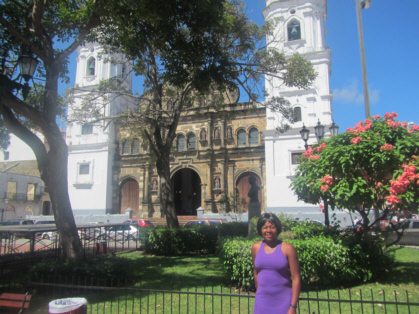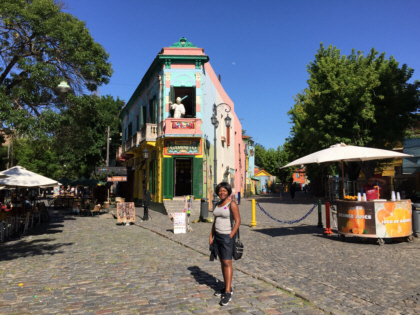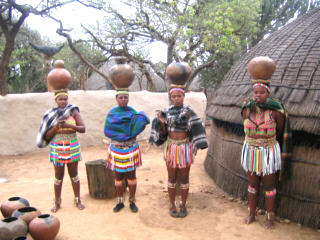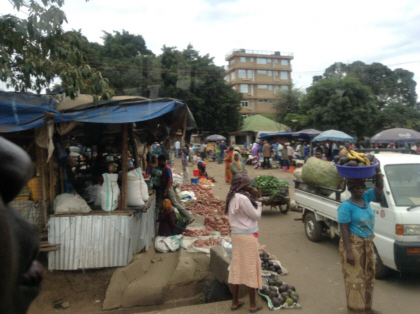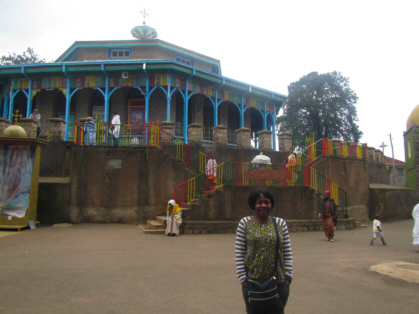Salvador da Bahia (continued)
From the São Francisco Church, we went to the Afro-Brazilian Museum where we learned about Afro-Brazilian culture, art, history, and religion. Paula narrated the tour. Once again, I was impressed by her knowledge of the exhibits we were seeing in the museum. We toured the museum for about an hour.
There were several street vendors in the Old City. There were guys pushing juice carts. There were people who would come up to you and try to sell you beads, jewelry, and crafts. Some of them were very persistent; however, they were always pleasant even if you refused to buy from them. My favorite street entrepreneurs were the three Bahian Ladies. These three ladies were dressed in tradition Bahian clothing and would pose so that you could take a picture of/with them. As soon as you took the picture, they were expecting money and they would follow you around smiling and/or flirting (in the case of a male photographer) until you gave them money. They even resorted to tickling a guy. I got a kick out of watching them track down the money. Traci took a picture of them without them knowing so they didn't follow us.
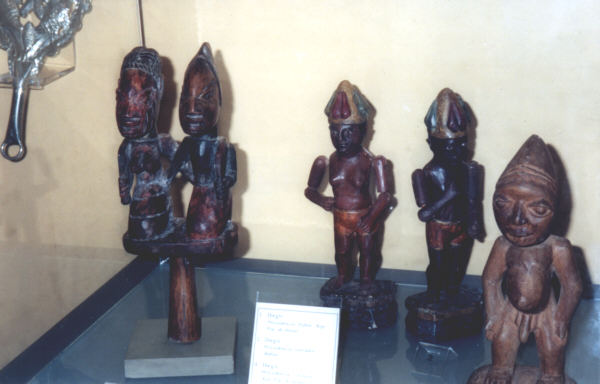
Afro-Brazilian Museum exhibit
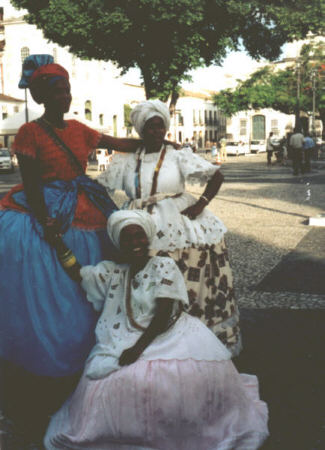
These ladies want money if you take their picture.
A short walk from the museum area is Pelourinho. This used to be a place of public whipping. Today it is a cobblestone street full of Baroque-style buildings and shops. Despite its history, Pelourinho is a true architectural gem. As Paula gave us a tour of the area she would point out places worth visiting during our free time. These places included restuarants that serve authentic Bahian food, a catholic church known for the drumming and dancing that occurs at the conclusion of Tuesday evening mass; a fortune teller; the rehearsal building of the group, Olodum; and many other sites. Tuesday night is the party night in Pelourinho. Paula told us to make sure we didn't miss this experience.
After touring the area, we boarded the bus and were shuttled back to our hotel. On the way there, Paula told us that our tour of the Lower City leaves a 9 a.m. and that she had put each of us in for a 7:30 a.m. wake up call. How's that for organization and efficiency? I was loving this.
Da Da Chicken
Later that evening, Traci and I decided to eat at one of the restaurants that Paula recommended on our tour of the Old City. The name of this restaurant was Sorriso da Dada. It was an easy name to remember compared to the Portugese names of the other restaurants Paula pointed out. We could simply tell a taxi driver "Da Da".
Traci and I hooked up with some of our other group members and took two taxis to the Old City. There were ten of us in all. The taxes ride, although short, was quite unnerving. It seems traffic lights are just for decoration. Our taxi driver took us as close as he could to the Pelourinho district. There were barriers restricting motor vehicle traffic at night. We paid the driver 5 Reals per person and navigated the cobblestone streets of Pelourinho on foot until we found the restaurant.
Sorriso da Dada is an interesting little restaurant. The ten of us were seated at a table in the back section. The interesting thing about this back section is that as long as you don't look up, you never realize that you are actually outside. Above us we could see the night sky, but we could also see clothes lines strung from the buildings surrounding us. These clothes lines had bed sheets, shirts, pants, and even panties hanging from them.
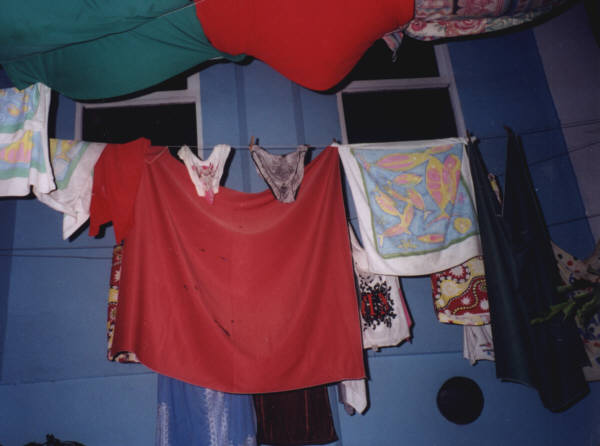
The "ceiling" of Sorriso da Dada Restaurant
We were given menus that were printed in Portugese, French, Spanish, and English. This restaurant served authentic Bahian food that seemed very foreign to us. Each of us ordered an entree, not knowing that the portions were big enough to feed two people. The waiters did not speak English so we pointed to what we wanted. This was also another opportunity to use my phrase book, but I didn't do too good.
After a long wait, our food finally arrived. However, the waiters placed the entrees in the middle of the table. Each of the entrees were covered in sauce. We couldn't tell which dish each of us had ordered. We asked for the menus and then attempted to ask the waiters which dish was which, but they did not seem to understand and walked off. After a while we just decided to get some plates and sample the various entrees. Most of the food was cooked with palm oil and coconut milk. There were a lot of seafood dishes with rice, shrimp, and/or fish covered in sauce. None of the food was exceptionally good or bad - just okay.
There was one lady in our group named Andrea, who had ordered a dish called Da Da Chicken. She couldn't tell if the waiter had brought it out. She was adamant about the Da Da Chicken. She kept trying to get the attention of the waiters, but they continuously ignored her and everyone else from our table. She began to complain loudly about not receiving her Da Da Chicken. The other people dining in the restaurant were getting a kick out of our table. They didn't speak English but I could occasionally hear them say "Da Da Chicken" and then laugh.
Meanwhile, as we were finishing up our meals, Andrea turned to her husband who had ordered some type of beef dish which was covered in sauce and asked how he liked his meal. He said it was okay. Suddenly, we heard Andrea say, "Is that a chicken bone on your plate?" Her husband said no, he ordered beef. She said, "That is a chicken bone in your plate. You ate my Da Da Chicken." She continued to give him the third degree about eating her Da Da Chicken. The rest of us were on the floor with laughter while the two of them were arguing over the meal. This one of my most memorable experiences in Brazil.
After dinner, we walked around the Pelourinho area and were eventually drawn to a club called Cortejo Afro where we heard some really good samba music. There was a live band with an excellent female singer. Also accompanying the band, was about a dozen youngsters that looked to be in their teens. These youngster were playing drums similar to what you would find in the drum section of a marching band. There were mainly varieties of toms and snares. This drum section ended up accompanying every live act that took the stage that evening. The rhythms definitely had an African influence. Most of the live performances we saw in Bahia had a drum section similar to the one we saw at the Cortejo Afro. It seemed to be the "Bahian Way".
Panoramic City Tour
We were up early Tuesday morning. We ate at the breakfast buffet in our hotel. This was a big buffet that included eggs, breakfast meats, cold cuts, cheeses, breads, danishes, tropical fruits, tropical juices, and cereals. The food was very good and free of charge. We ate there every morning while in Bahia.
After breakfast, we boarded the bus and began our tour of Bahia's Lower City. Our first stop was the Forte de Santo Antônio da Barra, Bahia's oldest fort. There were lots of persistent street vendors there trying to sell beads and jewelry. This fort was built in 1598 to defend Bahia from the English and Dutch. For a few reals you could see the inside of the fort. Traci had a pretty bad stomach ache so we just took pictures of the outside of the fort and got back on the bus. Fortunately, Traci's upset stomach subsided very quickly.
The next stop was the Marcedo Modelo. This is big market that sells all types of food, clothes, and souvenirs. There were shops set up outside as well as inside the three-story building. The vendors were willing to negotiate prices on their merchandise. Marcedo Modelo was only a twenty minute stop for us - not nearly enough time to explore this complex. Our tour guide, Paula, recommended we take public transportation later to come back and do some shopping. Traci and I caught a taxi back to Marcedo Modelo later that day.
After everyone was back on the bus, we headed to the Bonfim Church. This church is a Catholic church where people come to pray for healing. They often leave photos of themselves or the part of their body that they want healed. Some people leave behind plastic replicas of the body part that has been healed. These pictures and replicas can be seen in the rooms adjacent to the sanctuary. They hang from the ceiling and walls. It is really a sight to see. Bonfim is also the site of an annual Candomblé religious ritual where the people dress in white and parade to the steps of the church. This festival happens in January. Outside the church, there were hordes of street vendors trying to sell ribbons to tie around your wrist. These ribbons are supposed to bring you good luck if you wear them until they fall off. Traci and I didn't buy any. Continue...
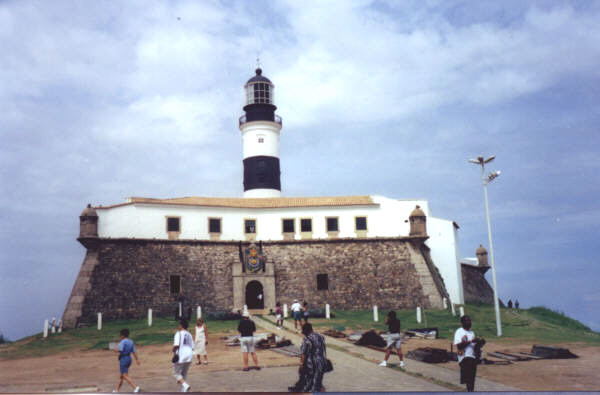
Forte de Santo Antônio da Barra
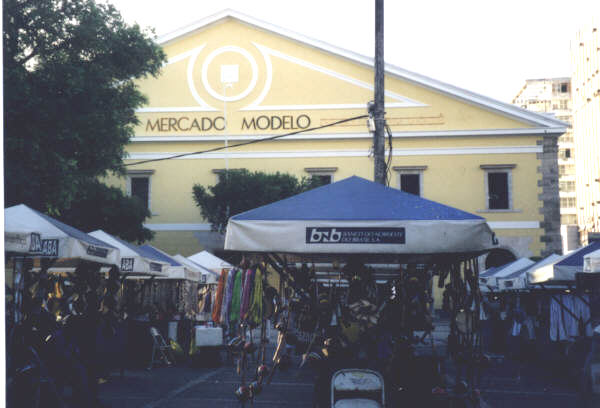
Marcedo Modelo
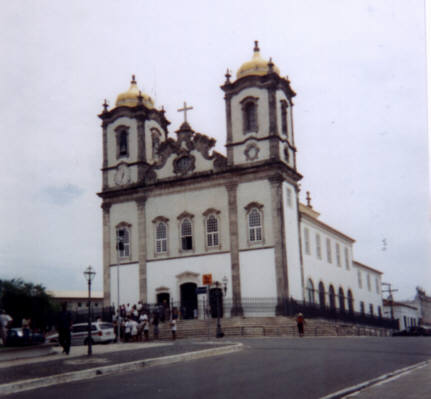
Bonfim Church
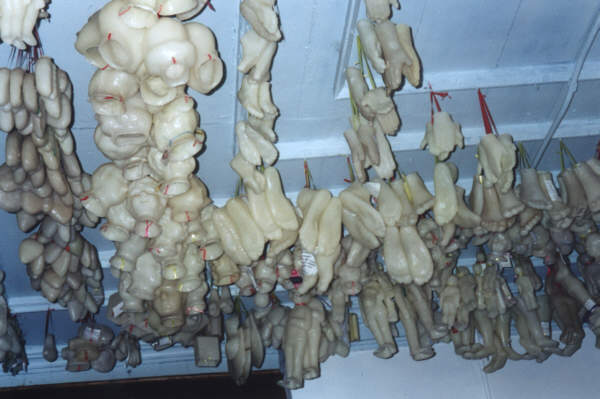
healed body part replicas in Bonfim Church
